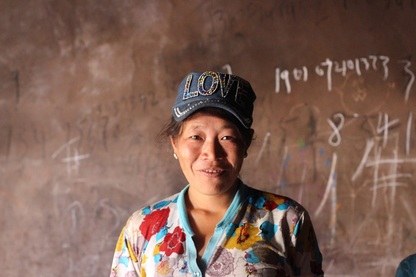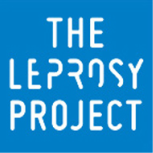 photo by Isobel Caldwell
photo by Isobel Caldwell Walewujian is 30 years old and lives in a village in Xide. She began doing embroidery eight years ago when the Leprosy Project hired some embroidery teachers to come to the village and teach the younger women about Yi embroidery and patterns. Prior to this, she already had sewing skills and would mend clothes and do some simple patterns. However, when they were learning how to embroider, Walewujian would spend extra time perfecting the patterns using discarded templates and instructions. “I feel happy that I have the skill and ability to embroider these patterns, and when I finish a piece and see that it looks good, I feel happy seeing my achievements and the product of my labours.”
Walewujian says that though the patterns they embroider do have meaning and significance in Yi culture, they do not know exactly what any one pattern means. Due to not being able to get an education and not being able to learn how to read or write, the women have had no way to properly record the meanings of each pattern and so they have simply passed the images down through the generations. She says that they are more concerned now with the overall look and aesthetic of the embroidery pieces, and use them to make bags or as patches on clothes.
She does know about the meanings of certain colours that are used. She says that the main traditional Yi colours are red, yellow and black. Fire is very significant in Yi culture, as they believe that you need it your entire life, whether for warmth, light or protection. In Yi culture, they always cremate those who have passed away so fire is present from the start to the end of your life. Red symbolizes fire, yellow symbolizes the flames of a torch as the torch festival is their biggest festival in Yi culture. Additionally, during the torch festival, it is common to see some members of society carrying yellow umbrellas. Black is a very common colour in Yi clothing and culture. Even today, elderly Yi people all wear traditional clothing and you will never see them wearing white, only black with various patterns on them. It represents the Yi nature and character, which is mainly solemn, serious and dignified. Various other colours such as green, pink and blue have been integrated into Yi patterns, but they are mostly used to look nice, rather than hold a particular symbolic meaning.
Walewujian is now able to sew any type of picture or pattern on request, for example, rabbits or dinosaurs, to which she adds a certain Yi flair. Her family encourages her to do the embroidery as it is a ready source of income and is also something that she enjoys. The money she makes from the embroidery is spent on supplies for her family, depending on what they might need most at the time. “I wish to learn more new patterns and incorporate more complicated styles of sewing into my embroidery, so as to further my skill set.”
Walewujian is from Meigu County in Liangshan. When she was 10 years old, her father passed away, and soon after, she was sent to Xide village to move in with the family of her husband to be. She has never had the opportunity to move back to her home village and neither her older sister or younger brother knew how to visit her in Xide, so overtime she has lost contact with them. Her mother moved to Xide village about 15 years ago, so she is able to see her often.
Her family was quite poor and neither of her parents saw education as imperative, so Walewujian was never able to go to school as a child. She never learned to read, write or speak Mandarin, and knows now how much that limits her in daily life. She has four children- one daughter and three sons- and three are currently attending primary school, the youngest not being old enough to begin school just yet. The children help her out around the house when they are home and work hard during the holidays and weekends. She says that her proudest moment was when she had her children, but it gives her even more hope seeing them getting an education. “Education is very important. For example, if you don’t learn to speak, read or write Mandarin Chinese, life will be extremely difficult if you when you go outside of the village, and it will be near impossible to create a prosperous life for yourself outside of a Yi village.”
Interview and translation by Georgie Reading
Edited by Isobel Caldwell
Walewujian says that though the patterns they embroider do have meaning and significance in Yi culture, they do not know exactly what any one pattern means. Due to not being able to get an education and not being able to learn how to read or write, the women have had no way to properly record the meanings of each pattern and so they have simply passed the images down through the generations. She says that they are more concerned now with the overall look and aesthetic of the embroidery pieces, and use them to make bags or as patches on clothes.
She does know about the meanings of certain colours that are used. She says that the main traditional Yi colours are red, yellow and black. Fire is very significant in Yi culture, as they believe that you need it your entire life, whether for warmth, light or protection. In Yi culture, they always cremate those who have passed away so fire is present from the start to the end of your life. Red symbolizes fire, yellow symbolizes the flames of a torch as the torch festival is their biggest festival in Yi culture. Additionally, during the torch festival, it is common to see some members of society carrying yellow umbrellas. Black is a very common colour in Yi clothing and culture. Even today, elderly Yi people all wear traditional clothing and you will never see them wearing white, only black with various patterns on them. It represents the Yi nature and character, which is mainly solemn, serious and dignified. Various other colours such as green, pink and blue have been integrated into Yi patterns, but they are mostly used to look nice, rather than hold a particular symbolic meaning.
Walewujian is now able to sew any type of picture or pattern on request, for example, rabbits or dinosaurs, to which she adds a certain Yi flair. Her family encourages her to do the embroidery as it is a ready source of income and is also something that she enjoys. The money she makes from the embroidery is spent on supplies for her family, depending on what they might need most at the time. “I wish to learn more new patterns and incorporate more complicated styles of sewing into my embroidery, so as to further my skill set.”
Walewujian is from Meigu County in Liangshan. When she was 10 years old, her father passed away, and soon after, she was sent to Xide village to move in with the family of her husband to be. She has never had the opportunity to move back to her home village and neither her older sister or younger brother knew how to visit her in Xide, so overtime she has lost contact with them. Her mother moved to Xide village about 15 years ago, so she is able to see her often.
Her family was quite poor and neither of her parents saw education as imperative, so Walewujian was never able to go to school as a child. She never learned to read, write or speak Mandarin, and knows now how much that limits her in daily life. She has four children- one daughter and three sons- and three are currently attending primary school, the youngest not being old enough to begin school just yet. The children help her out around the house when they are home and work hard during the holidays and weekends. She says that her proudest moment was when she had her children, but it gives her even more hope seeing them getting an education. “Education is very important. For example, if you don’t learn to speak, read or write Mandarin Chinese, life will be extremely difficult if you when you go outside of the village, and it will be near impossible to create a prosperous life for yourself outside of a Yi village.”
Interview and translation by Georgie Reading
Edited by Isobel Caldwell

 RSS Feed
RSS Feed
